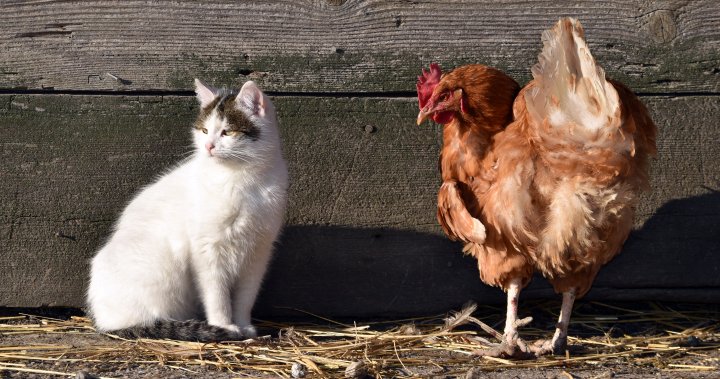As the fatal bird flu outbreak wipes out wild and domestic bird populations worldwide, researchers have identified surprising trends that could bring the virus closer to humans. There is a significant increase in infections in pet cats and other cat species.
Avian influenza, commonly known as avian influenza, has long been a concern for chicken and wild bird populations, but infections in mammals, especially pets, such as cats, have been historically rare.
But it appears to be changing rapidly, new research warns.
A systematic review published May 7th in Open Forum Infectious Diseases discovered a surge in avian influenza virus infections in cats around the world, particularly in relation to emergency H5N1 strains.
This trend could indicate an increased risk of viruses jumping from animals to humans, experts may warn.
This review, conducted by researchers at the University of Maryland, analyzed 20 years of scientific data on cat avian influenza from 2004 to 2024.
It recorded more than 600 cases in 18 countries and had over 300 deaths. Researchers have discovered a sharp rise in domestic cat infections over the past few years, particularly in 2023 and 2024.
The more cats infected with H5N1, the more they create a potential pathway for the spillover of the ecological wave between humans, the review warned.
“We estimate this phenomenon is underreported in the scientific literature and argue that an urgent need for increased surveillance in domestic cats,” the researchers said.

In the US, more and more bird flu infections are being reported in pet cats.
According to the US Department of Agriculture, 126 cats have tested positive for the virus since 2022, with about half of these cases occurring in 2024.

Get weekly health news
Receive the latest medical news and health information provided every Sunday.
Many infected cats were exposed by contaminated food or raw milk.
For example, in November 2024, two pet cats in California died after drinking raw milk contaminated with the virus.
More Video Details
Canada has not officially reported avian flu infection in cats, but that doesn't mean they haven't been occurring, said Shayan Sharif, professor and associate dean of the Ontario University of Veterinary Medicine at the University of Guelph.
Dogs in Oshawa, Ontario have confirmed at least one fatal case of avian flu.
Canada has also recorded avian influenza infections in other livestock and wild mammals, promoting concerns about the virus's ability to spread to species.
“H5N1 is already known to infect cats, domestic cats, and other cat species, such as tigers and mountain cats.
“What we didn't really know was how the cats were sensitive to H5N1, specifically to this particular new clade (2.3.4.4b). In fact, it became clear that their cats are sensitive to H5N1.”

How do cats get the bird flu?
Trend now

A terrifying suspect in Yemen placed under house arrest at Toronto Mosque

Canada Post suspends discussions with unions ahead of potentially looming strikes
Given how closely cats live with humans, researchers wanted to know how avian flu infections are spreading to cat populations.
This review showed that nearly two-thirds of all known cat infections are included in domestic cats, of which 71% were not alive. The main perpetrator is the new H5N1 strain (clade 2.3.4.4b) that first appeared in cats in 2022 and has been spreading rapidly ever since.
We also identified several ways in which cats are exposed.
Most people caught the virus by eating infected birds and raw meat. However, some cats get sick after drinking raw milk from an infected dairy cow.
Most of the cat infections reported in the review were confirmed or suspected to be the result of eating dead pigeons, chickens and other birds as well as eating contaminated raw chicken feed.
But it's not just outdoor cats.
“Interestingly, the recently reported case of H5N1 clade 2.3.4.4b by the Colorado Department of Health included two indoor only domestic cats that were not exposed to infected animals,” the researchers said.
“This observation raises concerns about new unknown transmission routes of (avian influenza) to domestic cats.”
What are the risks to humans?
Very rare, but the transmission of the virus from cat to human has been reported, the review says.
For example, in 2016, a cat-related outbreak of bird flu occurred in an animal shelter in New York City, causing more than 100 cats to be infected. A veterinarian suffering from a closely extended, unprotected exposure to the respiratory discharge of an infected cat has contracted the virus.
Sharif said the risk of cat-to-human transmission remains very low, but added that it is still important to be vigilant during this outbreak.
“In the case of bird effects, unfortunately, it is very fatal in cats,” he said.
“There are neurological signs like trembling and seizures. Unfortunately, there were also signs that you could become blind.”
If you think your cat is showing symptoms, he recommends contacting your local veterinarian immediately.
In the meantime, researchers in the review are calling for broader surveillance among dogs across the country to determine how the virus is spreading “to properly assess the risk of spillover to humans and other animals.”

&Copy 2025 Global News, a division of Corus Entertainment Inc.

